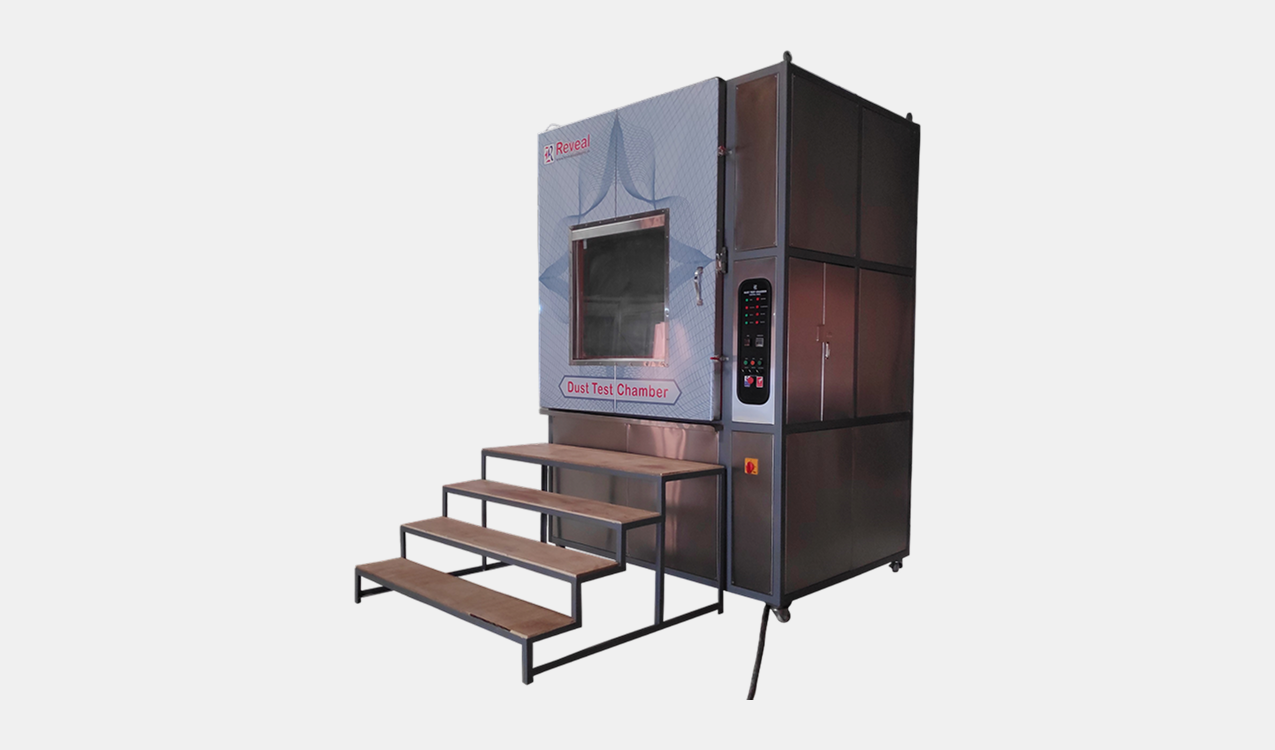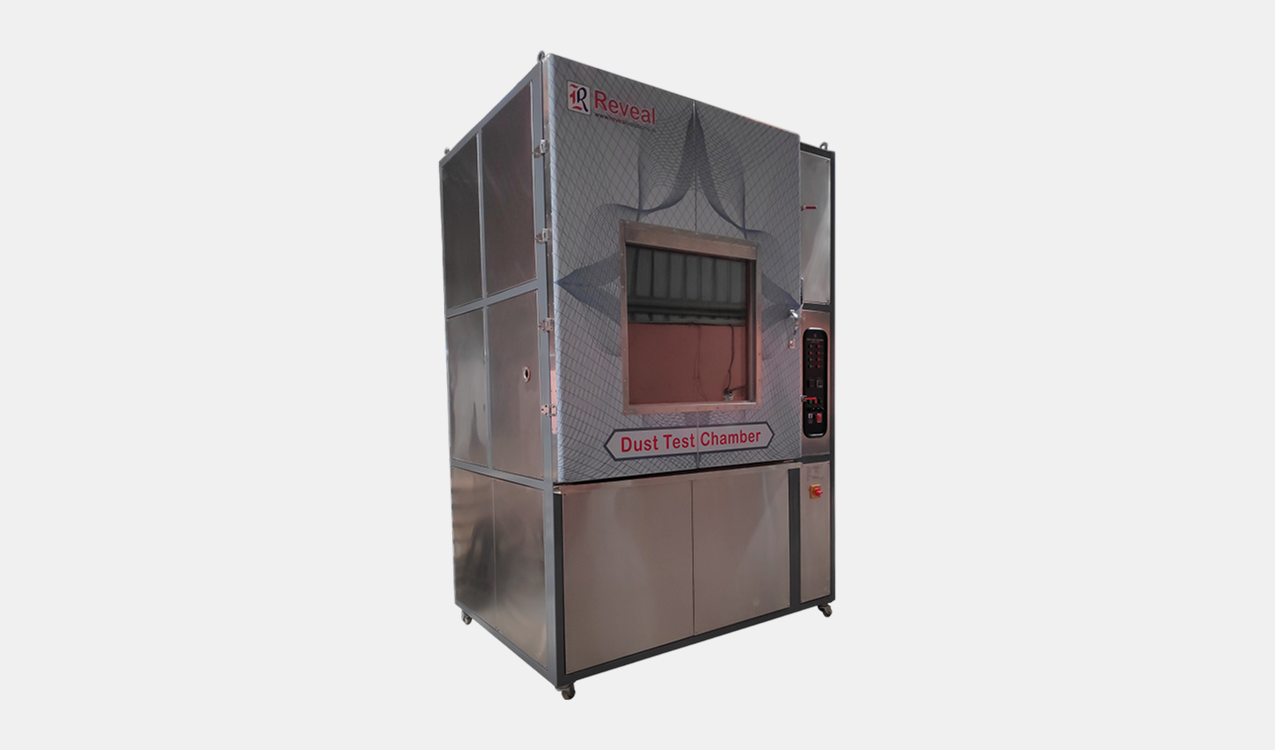Dust Test Chamber is a specialized environmental testing device designed to simulate dusty or sandy conditions to evaluate a product’s resistance to dust ingress, abrasion, or performance degradation in dusty environments. These chambers are used in industries like automotive, aerospace, electronics, military, and telecommunications to ensure products can withstand exposure to dust or fine particles, meeting standards.
Some Essential Features of Dust Test Chamber
These chambers are designed for reliability, accuracy, and long-term durability, with several key features:
-
Dust Delivery System
- Dust Reservoir: Holds standardized test dust (e.g., talcum powder, Arizona dust, or silica) specified by standards like IEC 60529.
- Blower or Circulation System: Disperses dust into the chamber, simulating blowing or settling conditions.
- Adjustable Flow: Controls dust concentration, velocity, and exposure duration.
-
Test Chamber
- A sealed enclosure, typically made of stainless steel or corrosion-resistant materials, to contain dust and prevent leakage.
- Sizes range from benchtop units (e.g., 500 liters) for small electronics to walk-in chambers for large items like vehicle parts.
- Includes filters or exhaust systems to manage dust and maintain air quality.
-
Control System
- Programmable controllers (e.g., touch-screen interfaces or software) to set dust flow, exposure time, and sometimes temperature or humidity.
- Supports standards like IP5X/IP6X (IEC 60529) or MIL-STD-810.
- Features data logging and remote monitoring via Ethernet or USB.
-
Safety and Monitoring Features
- Sensors to monitor dust concentration and chamber conditions.
- Alarms for system malfunctions or dust leaks.
- Dust collection or filtration systems to protect operators and the environment.
-
Optional Features
- Temperature/Humidity Control: For combined dust and climatic testing (e.g., hot, dry desert conditions).
- Vibration Integration: Can pair with a shaker (like vibration integrated environmental chambers) for simultaneous dust and mechanical stress.
- Walk-in Capability: Large chambers for oversized specimens or batch test.
Key Applications of Dust Test Chambers
Dust test chambers are used to ensure product reliability in dusty or sandy environments:
-
Electronics
Testing smartphones, tablets, or circuit boards for dust resistance (e.g., IP6X for dust-tight devices). -
Automotive
Validating sensors, headlights, or air filters against dust ingress on dusty roads. -
Aerospace
Ensuring avionics or aircraft components withstand dust exposure during ground operations or desert landings. -
Military / Defense
Testing equipment like radios or vehicles under MIL-STD-810 for desert or blowing sand conditions. -
Outdoor Equipment
Testing equipment like radios or vehicles under MIL-STD-810 for desert or blowing sand conditions.
Standard Models
| Models | Unit | RESPL DC-421 | RESPL DC-1000 | RESPL AC-1875 |
|---|---|---|---|---|
| Test Space Dimension (W X D X H) | mm | 750 x 750 x 750 | 1000 x 1000 x 1000 | 1000 x 1250 x 1500 |
| inch | 30 x 30 x 30 | 39 x 39 x 39 | 39 x 49 x 59 | |
| Test Space Volume | ltr | 421 | 1000 | |
| Temperature Range | (°C) | +10°C ~ 70°C | ||
| Test Time | 0 hour ~ 999 hours | |||
| Humidity Range | 45%Rh ~ 75%Rh | |||
| Mesh Diameter | 50 µm | |||
| Dust Dosage | 2 kg/m³ ~ 4 kg/m³ | |||
| Blowing Time | 0 hour ~ 999 hours | |||
| Temperature Sensor | PT 100 | |||
| Vibration Time | 0 hour ~ 999 hours | |||
| Time Accuracy | ± 1 minute | |||
| Power Testing Hole | 50 mm | |||
| Wire Spacing | 75 µm | |||
| Air Flow Speed | ≤ 2m/s (adjustable) | |||
| Dust Blowing Cycle | Continuous with cycles | |||
| Baking Dust Temperature Sensor | PT 100 | |||
| Test Standards | IEC 60529, ISO 20653:2006 | |||
| *We also manufacture chambers according to the customer's requirements. | ||||



